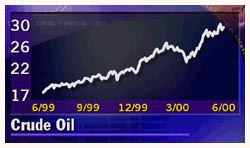|
OPEC tackles oil dilemma
|
 |
June 21, 2000: 12:22 a.m. ET
World's powerful cartel faces tough decision on measures to cut oil prices
By Rod Cant
|
VIENNA, Austria (CNNfn) - When members of the Organization of Petroleum Exporting Countries get together relations are rarely harmonious, but when the latest discussion starts up sometime on Wednesday representatives of the powerful cartel will face an unusually tough decision on whether to increase output to assuage rising energy prices.
 Crude oil prices have been at unprecedented highs over the past few months, around $30 per barrel, or more than double the price of a year ago. Crude oil prices have been at unprecedented highs over the past few months, around $30 per barrel, or more than double the price of a year ago.
A price of around $25 would suit both producers and buyers - the United states is OPEC's largest customer, but the road to a stable oil price at that level is fraught with difficulty.
Opinion within OPEC appears divided over whether to add 500,000 or 1 million barrels per day to output. The smaller increase would mean a rise of around 2 percent in OPEC production. The 7 percent increase agreed to in March did little to cap the price surge.
Almost everyone agrees that such a level is not healthy for the long-term future of both the global economy and the oil producing countries. Sooner or later, consumers and companies are going to start reining in their use of gas-burning products, or look for alternative fuels.
Already, consumers in the United States are laboring under painful average gas prices of $1.70 a gallon, based on the Energy Information Administration's weekly survey of 800 service stations, while prices in Europe, traditionally higher than in the U.S. because of greater government taxation, have soared even more.
"The current level of oil prices is simply unsustainable...to keep the price at these levels would mean starving the world of the oil it needs," according to Julian Lee, a director of the Center for Global Energy.
Put simply, high oil prices will choke off demand in the economy, possibly ending the consumer-led boom that has powered the United States through a record period of growth, and cutting off the nascent economic revival in continental Europe.
Prices have risen, at least in part, because OPEC members have maintained an unusual degree of discipline over the past year, with individual states sticking to their agreed production levels. Previous efforts at some form of price control generally fell apart, as states could not resist surreptitiously boosting their output to maximize revenue.
Why don't they just turn the taps on?
The obvious answer is for OPEC to turn the taps on, allowing more oil to flow, and bringing the price down. But it's never that simple with OPEC however, and several undercurrents are certain to prevent the meeting from running smoothly.
At its last meeting in March, OPEC agreed to boost output in the face of strong demand from the United States and others for prices to fall. The impact was limited however, and prices have continued to rise. OPEC failed to implement a further, informal agreement to boost production after crude price rose out of the $22 to $28 per barrel range.
The U.S. administration has voiced fewer public protests this time around, perhaps because Iran opted out of the formal agreement to boost production last time, ostensibly on the grounds that it would not bow to American pressure.
Oil stocks are rising
Some OPEC members have vivid memories of the collapse of oil to below $10, and its catastrophic impact on their revenues. They would prefer to inch output higher, and avoid any danger of a slump in prices later in the year.
Encouraging the view that any increase should err on the side of caution, world oil stocks have been rising recently, although analysts point out the data is notoriously inaccurate and often tells an incomplete picture. Much of the oil being hoarded is in Asia, whereas the strongly growing economies of the West are where the commodity is most needed.
Some form of output boost seems the inevitable result of the meeting, although as the delegates scuttle from room to room the tension between the hawks - inevitably including Iran - and the doves who favor a more significant opening of the taps - including Saudi Arabia - is bound to rise.
The delegates are expected to meet for several days before a communiqué is issued, detailing the agreement.
Lee, of the Center for Global Energy, thinks the outcome will be a production increase of more than 500,000 barrels per day, and he calculates that "should take crude to an average of around $25 in the final quarter of the year."
Such a deal is likely to make all parties happy, momentarily at least. 
|
|
|
|
|
 |

|

